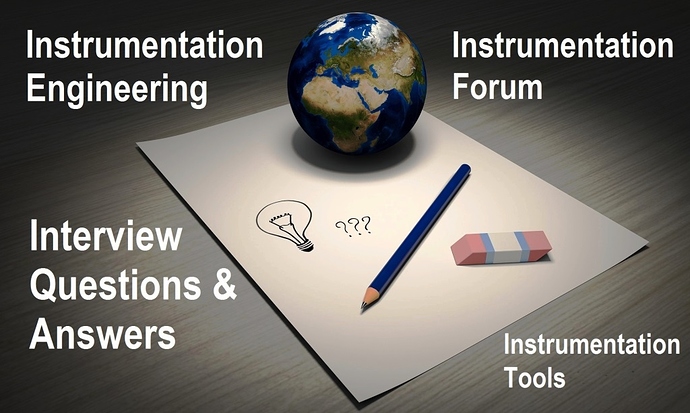Instrumentation engineering interview questions answers
Question. What are the active and passive components in instrumentation?
Answer: Active Components: as we know that the components or devices which require an external source for their operation are known as Active Components
For example- transmitter, control valves, indicators, PID controller etc.
Passive components: as we know that the Components or devices which do not require an external source for their operation are known as Passive Components.
For example: Resistance temperature detector (RTD), Thermocouple, Pressure gauge, temperature gauge etc.
Question. What are the different types of pneumatic control valves are used?
Answer. The different types of pneumatic control valves are as following
-
Globe valve
-
Butterfly valve
-
Ball Valve
These valves are further categorized into two categories
ON-OFF Valve: A solenoid valve is used to open these types of control valves. As the name indicates these control valves are fully opened or fully closed valves.
Continuous opening Valve: These types of control valves are operated by the use of an I to P converter (Current to Pressure Converter) and a pneumatic positioner or an Electro-pneumatic positioner. These types of valves are opened in percentage.
Continuous opening valves are categorized into two categories.
Air to open or normally closed valves: As the name indicates, these control valves are opened on apply air and in the absence of air these valves remain closed.
Air to close or normally opened valves: As the name indicates, these control valves closed on apply air and in the absence of air these valves remain open.
Globe valves are mostly used in industries because globe valves can be used at high pressure and temperature.
Question. What is the role of an I to P converter (Current to Pressure Converter) and a pneumatic positioner in the opening of a control valve?
Answer: An I to P converter (Current to Pressure Converter) and a pneumatic positioner play an important role in the opening of a pneumatic control valve.
An I to P converter (Current to Pressure Converter) or I/P, converts the current signal (normally 4-20 m ampere) to a Pneumatic signal. A Pneumatic positioner acts as an actuator and used to control the opening of a pneumatic control valve.
For controlling pneumatic control valves, an electro-pneumatic positioner is also used. In this type of system, I/P and a pneumatic positioner are combined. This combined system is used to control the opening of a control valve.
Question: How temperature signal is transmitted from the field to a PLC or DCS or a Controller
Answer: The temperature signal comes from Resistance temperature detector (RTD) or Thermocouple. This signal can be transmitted to any control device in two ways-
Direct: The signal is transmitted or wires from Resistance temperature detector (RTD) or Thermocouple are connected directly to the control devices like- PLC or DCS or Controller.
Using Temperature Transmitter: A temperature transmitter is used to transmit the signal, the temperature transmitter transmits a 4-20 m Ampere signal to the control devices like- PLC or DCS or Controller.
By using the temperature transmitter, resistance temperature detector (RTD) signal and thermocouple signal are converted into a 4-20 m Ampere signal and these signals are transmitted to the control devices.
Question. What is the use of the flow orifice plate?
Answer: The flow orifice plate is used for the flow transmitter. The flow orifice plate is used to provide the differential pressure to calculate the flow of the process line.
The different types of orifice plates are:
• Concentric.
• Segmental.
• Eccentric.
• Quadrant Edge.
Question. Define the working of a Solenoid valve?
Answer: solenoid valve has a single input and two outputs. Air is given at input port and when the coil is not energized air extracted from one output end and when the coil is energized air extracted from another output end.
The solenoid is normally used for opening and closing of different types of control valves. One output air is used for closing the valves and other output air is used for opening the valves.
Working Principle:
A solenoid valve has two main parts: the solenoid (coil) and the valve. The solenoid converts electrical energy into mechanical linear motion which, in turn, opens or closes the valve mechanically.
A spring is there in solenoid valve when supply is given to coil it gets energized and spring moves which open or closes the valve mechanically.
Solenoid converts electrical energy into mechanical energy and this energy is used to operate a mechanical valve that is to open, close or to adjust in a position.
Question. What is the role of the wheel in a pneumatic control valve?
Answer: The wheel is used to operate a control valve manually. In some valves, the neutral position is given. In the neutral position control valve is operated through the air.
In other position, different from neutral position control valve is operated through the wheel manually. In some control valves, this wheel is not given.
Control Valve with the wheel is called the control valve with manual function.
In the control valves in which neutral position is not given, if the wheel is moving freely control valve is in auto mode it will be operated through air signal.
If the wheel is not moving freely control valve is in manual mode, it will be operated through wheel operation and in this case, air supply should be off.
